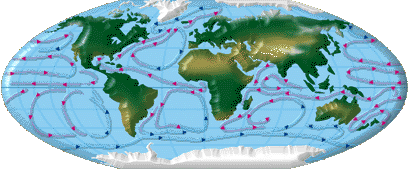
[ home port | lectures | labs | surf | email prof. ]


Low pressure zones
High pressure zones
High pressure zones
Winds are caused by the movement of air from regions of high pressure to regions of low pressure.
Current direction
Rotation of the earth.
object moving relative to the earth in the Northern Hemisphere will be deflected to the right.
Speed of the object.
The greater the pressure differential the steeper the gradient.
Water flows from the areas of high pressure to areas of low pressure.
Stable, constant
right in the Northern Hemisphere
left in the Southern Hemisphere
Location of continents
Vorticity
Last update: April 25, 2000
warm air rises (hot air balloon)
cool air sinks
Heated Air Rises, Cool Air Sinks
Atmospheric Pressure
Low pressure zones
increasing water vapor content along with increased temperature.
decreasing water vapor content or decreased temperature.
Pressure Gradients
Differences in air pressure across a horizontal gradient cause pressure gradients.
Differences in air pressure cause winds
A Note on Winds vs. Currents
Wind direction
- Indicates where the wind comes from, i.e. a westerly wind flows from the west to the east.
- Indicates where the water flows to, i.e. a southerly current flows to the south.
Winds (Figure 6-3a)
Differences in air pressure give rise to winds. The direction of the winds is also affected by the:
Coriolis effect (apparent deflection)
F
Coriolis Effect (Figure 6-2)
Rotation of Earth from West to East
A systematic deflection
Observer in space doesn't see it
Observer on Earth sees movement as an apparent deflection
object moving relative to the earth in the Southern Hemisphere will be deflected to the left.
Coriolis "Movie"
Coriolis Magnitude
The magnitude of the Coriolis deflection depends on the
Location on earth.
No deflection at the Equator
Increases towards the poles
Local Coriolis Effects?
not in toilets or sinks, due to friction
Surface Ocean Currents
Surface currents are driven by winds. They are due to the interaction of:
Wind drag
Pressure gradients
Coriolis deflection
Currents are deflected by continents creating circulation gyres.
"Oceanic" Pressure
Changes in pressure across a horizontal distance of the ocean causes currents in the ocean as in the atmosphere.
Surface of Ocean Like Inverted Bowl!
The ocean surface within circulation gyres is not flat; there are mounds and depressions.
Mounds of Water (Figure 6-9)
Ekman Transport (Figure 6-6)
Mounds from Ekman Transport (Figure 6-9)
Ekman Transport Nearshore
Ekman transport leads to:
Upwelling along coastlines
Downwelling along coastlines
depending on wind direction
Winds-->Ekman T.-->Mounds-->Geostrophic Flow
Geostrophic flow refers to steady current flow that results from a balance between a pressure gradient and Coriolis deflection.
Always in equilibrium
Directions of Currents (Figure 6-4)
Water currents are deflected because of the Earth's rotation and the Coriolis force.
"Fastest Guns in the West"
The intensification of western boundary currents is caused by the:
(Figure 6-10)
- Earth's rotation
- the squeezing of water along the western edges of ocean basins.
- the circular rotation of water parcels around a vertical axis.
Tracking Currents:
The Story of the Lost Nikes
http://dusk.geo.orst.edu/oceans/lec13H.html